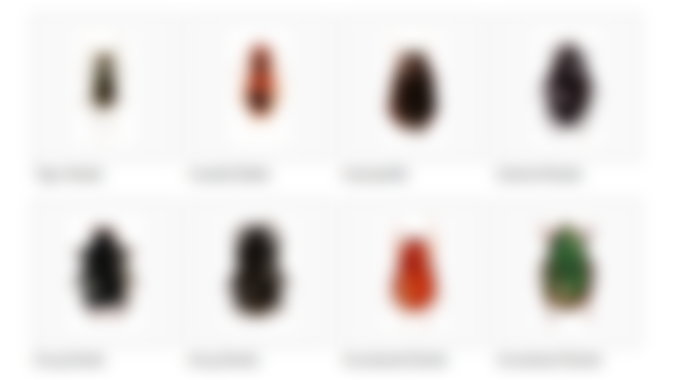Beetle common name for insects of the order Coleoptera, which with over 2,80,000 described species, constitutes the largest of the insect orders. The major diagnostic characteristic of the beetle is the modification of the forewings into hardened wing covers, or elytra. These may be rigid, thickened or leathery, and lie over the back, meeting in a middorsal line. The membranous hindwings are used for flight in most species. The elytra serve to support the body during flight and protect the hindwings when at rest.
The body of the beetle is hard but built on the general insect plan consisting of head, thorax and abdomen; in beetles, however, the last two thoracic segments are joined to the abdomen, and the prothorax lies under a protective plate called pronotum.

As members of the largest order, there is a great diversity of form and adaptations in beetles. In many, the elytra are brightly coloured or patterned. The ground beetles (Carabidae) have an oval, flattened body; in water beetles (Hydrophilidae) the underside is very smooth and there are long hairs on the hindlegs that give greater surface when swimming. The lady beetles (Coccinellidae) are round in contour and flat below; stag beetles (Lucanidae) have enormously enlarged mandibles; a long and backwardly directed antennae and slender body. The fireflies (Lampyridae) have soft Electra and can produce light; weevils (Circulation) have their mouth parts at the tip of the snout.
Beetles live on plants, underground, in water, as commensals in the nests of various social insects, in rotten logs and in other habitats. Many beetles are predaceous. Adult ground beetles are nocturnal and feed on various insects and also snails. Both larval and adult diving beetles (Dytiscidae) eat insects and small fish. Lady beetles eat aphids and scale insects, while soldier beetles (Candidature) prefer worms and various insect larvae. Fireflies mostly eat snails. On the other hand, a large number of beetle species eat plants. Certain beetles (Scolytidae) share their arboreal habitat with particular fungi.
Among the beetles, some are subject to a fair amount of predication. Frog, birds and certain mammals are insectivorous and feed on beetles among other insects. Tachinid flies parasite adult beetles and various wasps parasite beetle larvae.
Most beetles are bisexual and the females are oviparous although there are a few parthenogenesis species. They undergo a complete metamorphosis. Beetles under the following families are found in Bangladesh.
Carbide (ground beetles) - Largely ground living forms found under stones, bark, rotten wood and other similar situations. They are carnivorous both as larvae and adults. Calosoma is predaceous on caterpillars.
Cicindellidae (tiger beetles) - Electra often brilliantly colored; mandibles sharp. Predatory as larvae and adults. Cinderella sexpunctata is a predator on the rice bug. Hydrophilic (water scavengers)- mostly aquatic, adults feed on decomposing vegetable matter. Hydrophilic is a common genus.
Histeridae (hinter beetles) - Mostly predaceous or saprophagous. The species of Hister is found in dung and decomposing substances. Lampryidae (glow worms, fireflies)- soft-bodied, nocturnal beetles with photogenic organs on abdominal segments 6 and 7. Buprestidae (metallic wood boring beetles)- colour metallic green, golden, bronze, or blue. Larval prothorax large and expanded. Charysochroa sp., an irrideseent green beetle, is common. Sphenoptera gossypii is the cotton stem borer.
Dermestidae (skin beetles) - Both larvae and adults feed on leather, hair, wool, dry meat, etc. Dermestes species, are pests of dried fish. Trogoderma granarium feeds on stored rice and wheat. Coccinellidae (Ladybeetles)- the great majority of the species feed on aphids, coccids, etc; others are phytophagous. Coccinella, Adatia, Chilomenes, Scymnus are the common predaceous genera occurring in Bangladesh; Epilachna species are phytophagous.
Tenebrionidae (darkling beetles) - Red flour beetle, Trilobium species, are pests of flour. Tenebrio molitor is the well-known mealworm, a pest of cereal products. Bostrychidae- species of Sinoxylon and Dinodems are extremely destructive to bamboo and felled trees. Rhyzopertha dominica is a pest of stored grains.
Anobiidae (deathwatch beetles) - Anobium striatum is destructive to furniture. Lasioderma sericorne is the cigarette beetle. Scarabaeidae (scarabs, dung beetles)- most species are ornamented, with lamellate antennae, and horns. Larvae are called white grubs. Onthophagus, Copris, Heliocopris, Onitis, Oxycetonia are common genera. Oryctes rhinoceros is destructive to the coconut tree. Bruchidae (pulse beetles)- species of Bruchus and Callosobruchus are pests of pulses.
Chrysomelidae (leaf beetles) and the allied families Galerucidae, Hispidae and Cassididae have nearly similar habits, and were originally treated as subfamilies of the Chrysomelidae. Both adults and their larvae feed exclusively on the leaves of a variety of plants; some of them are serious pests of cultivated crops and vegetables. Aulacophora species, Altica, Galemcella, Monotepta species. Dicladispa armigera, Aspidomorpha spp. are among the common leaf beetles. [Monawar Ahmad]
Dung Beetle Name for a group of highly specialised coprophilous beetles of the subfamily Scarabaeinae. Although the members of the family Scarabaeidae are commonly known as dung beetles or lamellicorn beetles, the name dung beetle is usually restricted to the dung inhabiting species. On the basis of food habit the scarabaeids are categorized into two types as, phytophagous, where adults feed on plant materials and pre-adult stages pass either in animal excreta or decaying organic matter; and scavenger beetles subsisting primarily on dung/decaying organic matters. They are usually found in association with dung pads, carrion, biological refuges of all kinds, humus, rotting wood and fungi. It is reported that in India during May and June as much as 40-50 thousand m tons of exposed excrement are carried by scarabs each day into the soil. Dung beetles habitually dig tunnels in the soil under dung pads and carry a fragment of dung at the bottom for consumption or breeding purposes. This habit increases soil fertility and porosity. The scarab dung beetles also play a role in reducing populations of parasitic organisms living in various types of dung.
A recent survey on scarab dung beetle fauna from different parts of Bangladesh reports 35 species under eight genera of which 20 species belong to the genus Onthophagous, five to Cathersius, three to each of Caccobious and Oniticellus, one species to each of Copris, Heliocopris, onitis and Gymnopleurous. Twenty eight species of leaf-eating scarabeids belonging to three sub-families have also been recorded from Bangladesh, of which 17 species are under Rutellinae, five under Dynastinae and six under Aphodiinae. [M Zahidur Rahman Majumder]
Leaf Beetle Any of the members of the insect family Chrysomelidae, order Coleoptera. This family, comprising approximately 37,000 species in over 2000 genera and 16 subfamilies, is essentially phytophagous. Its food item is not, however, restricted to leaves only, it mines leaves, makes tunnels in the stem, root and other parts of plants. They are variable in body size (0.5-35 mm). Usually glabrous, some are pubescent, scaly or densely spined. The shape is also variable- slender, oval, hemispherical or flattened. Their colouration ranges from pale yellow to dark and often with lustrous metallic dorsally. Several dozens of chrysomelids have been recorded in Bangladesh, and some are serious pests of cultivated crops. At least 9 species are known to be defoliators. Among the pest species Dicladispa armigera or rice hispa, locally known as Pamri Poka is a serious pest of rice plants.
Podontia quatourdecempuncta is a serious defoliator of 'Amra', Spondias species and Ficus elastica. Its larva and adult defoliate the plant completely. Another serious defoliator has been recorded from keora, one of the dominant plant species of the sundarbans.
Aulacophora abdominalis is a common pest of cucurbitaceous plants. Nodostoma viridipenis is a serious banana fruit and leaf-scarring pest. Colopsis hypochlora and Sphaeroderma are two other banana leaf-eating chrysomelid. Phyllotrea (cabbage flea beetle), potato beetle Leptinotarsa decimplineata, Typophorous nigritus, and Monoleta signata are worth mentioning as chrysomelid pests. [M Sohrab Ali]
Ladybird Beetle Common name for any of the members of the family Coccinellidae, class Insecta. About 490 genera and over 4200 species of lady beetles have been described worldwide. These beetles are mostly oval from the dorsal profile, minute to medium sized (0.8-18 mm) and brightly coloured, sometimes with a beautiful pattern on the punctuate elytra and pronotum, which may be pubescent or smooth. Most of them have a 11-segmented clubbed antennae though in some cases the number may be reduced to 7.
These insects as larvae and adults are usually thought of as beneficial predators of plant pests, such as aphids, coccids, psyllids, white flies, pseudococcids, phytophagous mites, etc. A sizable number of species (over 500) belonging to the subfamily Epilachninae are however, plant feeders, and some members are fungivores.
Biological control and ladybird beetles are historically interliked. The suppression of cottony cushion scale, Iceyra purchasi by the vedalia beetle, Rodolia cardinals, in California citrus groves in 1898 is unparallel in the annals of entomology for its drama, human interest, and continuous significance.
Parasitic hymenopterans, fungi, protozoans, nematodes, predatory dipterans, spiders, acari and some birds are the natural enemies of ladybirds. Under five subfamilies and 33 genera about 80 species of beneficial ladybirds, and about 13 species of phytophagous ladybirds belonging to the subfamily Epilachninae have been recorded in Bangladesh.
Some Species of the ladybirds of the genera Micraspis, Coccinella, Harmonia, Menochilus, Cheilomenes, Propylea, and Brumus are quite abundant in different crop fields and play an important role in suppressing the pest population, particularly the aphids and scales.

I appreciate your work that's very informative for us.you are doing great job .I'm very excited for your next articles.I already subscribed you ... please u also support me by subscribe ...& Visit my article hope you like it https://read.cash/@Alx/awesome-cat-facts-you-need-to-know-bee15d5e